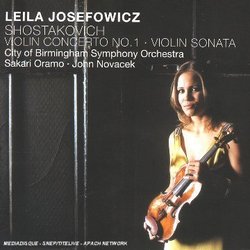| All Artists: Dmitry Shostakovich, City of Birmingham Symphony Orchestra, John Novacek Title: Shostakovich: Violin Concerto No. 1; Violin Sonata Members Wishing: 1 Total Copies: 0 Label: Warner Classics Original Release Date: 1/1/2006 Re-Release Date: 6/20/2006 Album Type: Enhanced Genre: Classical Styles: Chamber Music, Forms & Genres, Concertos, Instruments, Strings, Symphonies Number of Discs: 1 SwapaCD Credits: 1 UPC: 825646299720 |
Search - Dmitry Shostakovich, City of Birmingham Symphony Orchestra, John Novacek :: Shostakovich: Violin Concerto No. 1; Violin Sonata
 | Dmitry Shostakovich, City of Birmingham Symphony Orchestra, John Novacek Shostakovich: Violin Concerto No. 1; Violin Sonata Genre: Classical
Twenty years separate the composition of these two works. Both bear Shostakovich's signature traits: the emotional extremes, the mercurial mood and character changes, but the Concerto, written in 1948, is more assertive, f... more » |
Larger Image |

 Track Listings (7) - Disc #1
Track Listings (7) - Disc #1